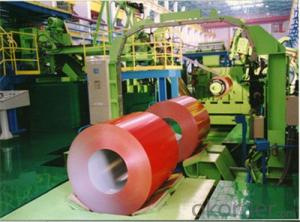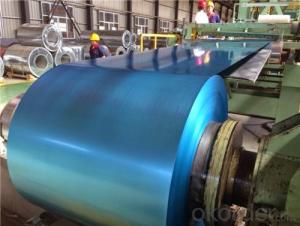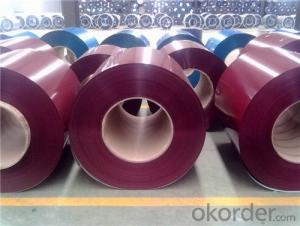Prepainted Rolled Steel Coil for construction roofing Constrution
- Loading Port:
- Shanghai
- Payment Terms:
- TT OR LC
- Min Order Qty:
- 50 m.t.
- Supply Capability:
- 30000 m.t./month
OKorder Service Pledge
OKorder Financial Service
You Might Also Like
Structure of Prepainted Rolled steel Coil for Construction Roofing

Description of Prepainted Rolled steel Coil for Construction Roofing
Prepainted Rolled steel Coil is a kind of coated steel coil/sheet. With the cold rolled steel of different strength and thickness as substrate, it is produced through applying Al-Zn coat on both faces by hot dip process. In its coating, Al accounts for about 55%, Si 1.6%, while the remaining is Zn. Aluminum zinc coils enjoys both the physical protective feature and durability of Al and the electrochemical protective property of Zn. And its surface has bright silver color and regular embossed-like figure, which are highly decorative.

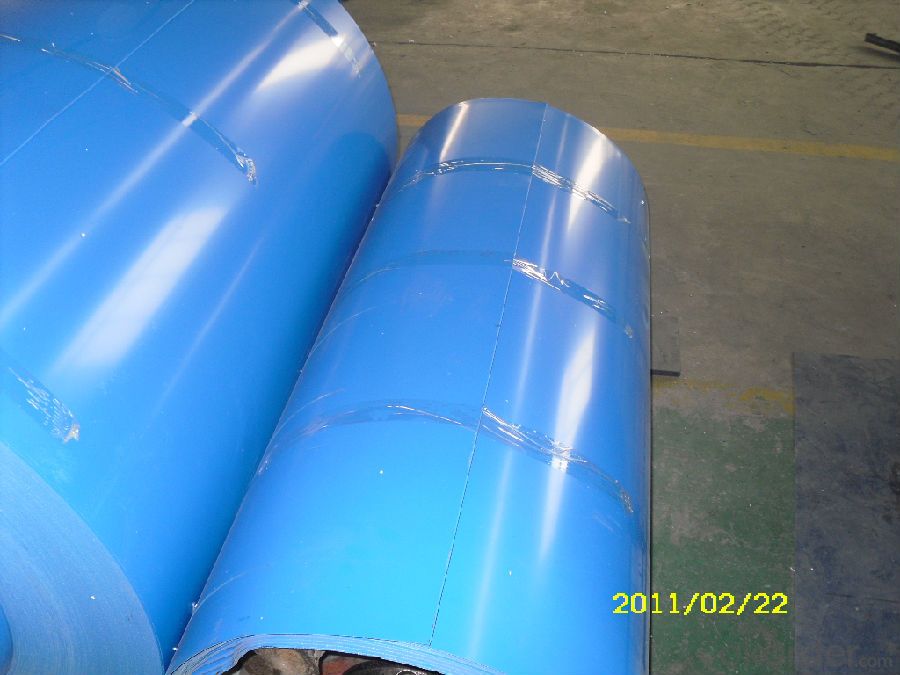
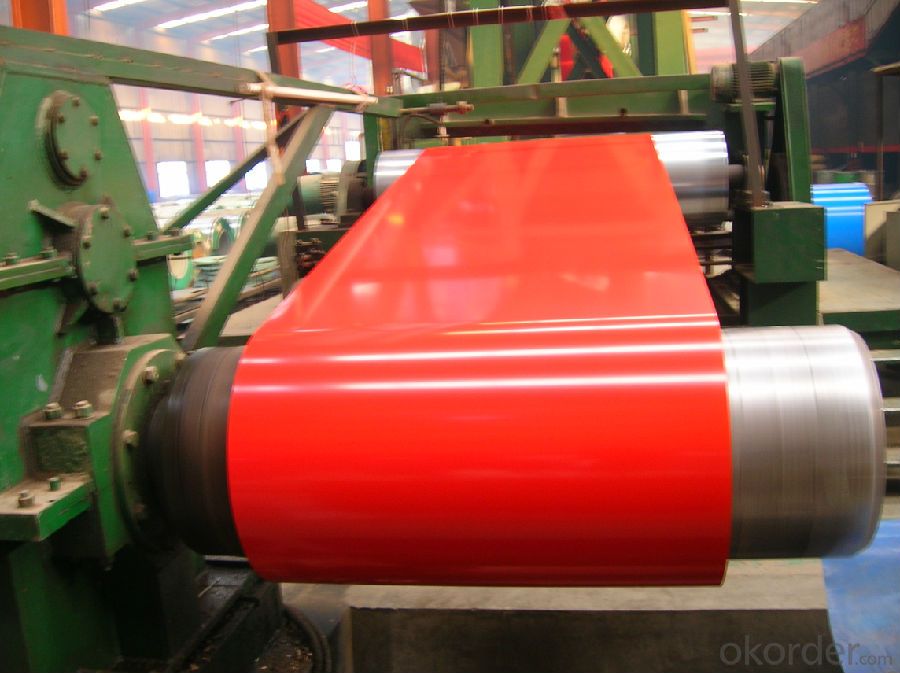
Main Feature of Prepainted Rolled steel Coil for Construction Roofing
1.Corrosion resistance: It mainly depends on the aluminum protection. When the zinc being worn, the aluminum will form a dense layer of aluminum oxide, resist corrosion material to prevent further corrosion inside.
2. Heat resistance: Aluminum zinc alloy steel sheet has excellent heat resistance, can withstand high temperatures over 300 centigrade, and is similar with aluminized steel high temperature oxidation resistance. It often used in chimney pipes, ovens, fluorescent lighting device and the device cover.
3. Heat reflective: Galvanized steel plate heat-reflective high rate is twice as galvanized steel, often used to make insulation materials.
4. Economy: Because density of 55% AL-Zn is smaller than the density of Zn, so in the same weight and thickness of Galvanized zinc layer, aluminum-zinc steel plate is larger area more than 3% of galvanized steel sheet.
Applications of Prepainted Rolled steel Coil for Construction Roofing
1. Construction and building: roofing; ventilating duct; handrail; partition panel;etc.
2. Electric appliance: refrigerator; washing machine; refrigerator; DVD;etc.
3.Transportation: oil tank; road sign; etc.
4.Agriculture:barn; etc.
5.Others:vending machine; game machine; etc.
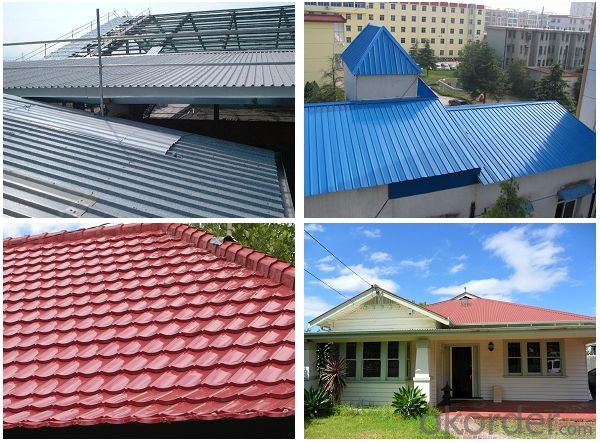
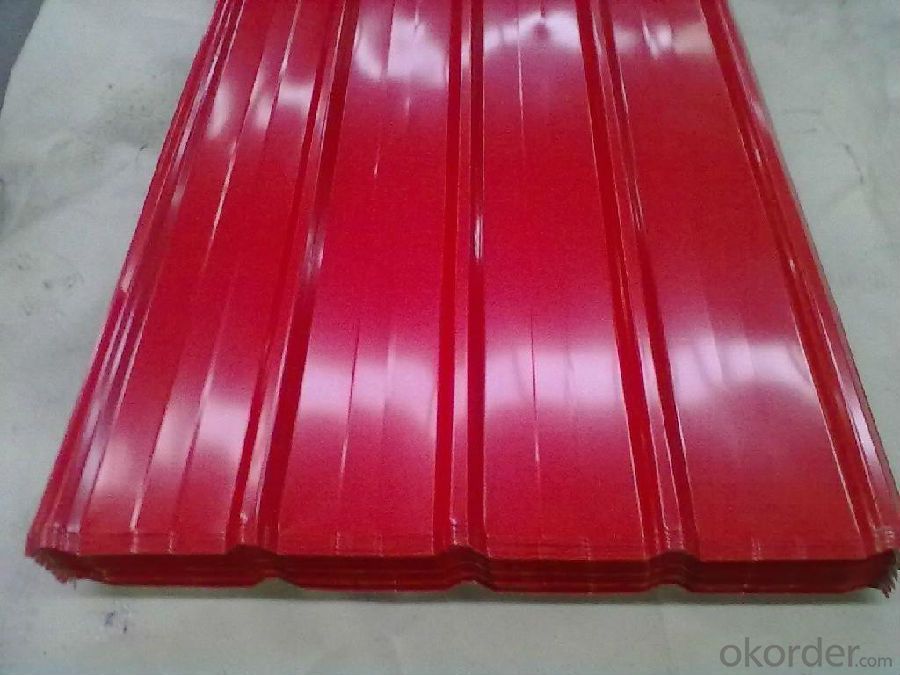
Specifications of Rolled steel Coil for Construction Roofing
Product | Prepainted Rolled steel Coil for Construction Roofing |
Material Grade | SGCC / SGCH / DX51D+AZ, etc |
Thickness | 0.2-3.0mm |
Width | 600-1500mm |
Tolerance | Thickness: +/-0.02mm , Width:+/-2mm |
Zinc-coating | AZ40-150g/m2 |
Technique | Raw material: Hot rolled steel coil --> Cold rolled_>hot dipped galvalume |
Surface | Dried, Chromated, Unoiled |
Spangle | Regular spangle , small spangle, zero spangle |
ID | 508MM |
Coil weight | 10MT max |
Export package | Cardboard inner sleeves, Waterproof paper, galvanized steel covered and steel strip packed |
FAQ of Prepainted Rolled steel Coil for Construction Roofing
We have organized several common questions for our clients,may help you sincerely:
1. What is the minimum order quantity ?
Our MOQ is 50mt for each size. And we will consider to give more discount if you make big order like 1000 tons and more. Further more, the more appropriate payment term your offer the better price we can provide.
2. How long can we receive the product after purchase?
Usually within thirty working days after receiving buyer’s advance payment or LC. We will arrange the factory manufacturing as soon as possible. The cargo readiness usually takes 15-25 days, but the shipment will depend on the vessel situation.
3. How to guarantee the quality of the products?
We have established the international advanced quality management system,every link from raw material to final product we have strict quality test;We resolutely put an end to unqualified products flowing into the market. At the same time, we will provide necessary follow-up service assurance.
- Q:What are the common coil packaging materials?
- Common coil packaging materials include plastic wrap, stretch film, steel strapping, and wooden crates. These materials are used to protect and secure coils during storage and transportation, ensuring they remain intact and undamaged.
- Q:How are steel coils used in the production of power transmission towers?
- Steel coils are used in the production of power transmission towers because they provide the necessary strength and structural integrity required to support the transmission lines. The coils are formed into various sections and welded together to create the tower's framework, ensuring it can withstand the weight of the cables and withstand external forces such as wind and seismic activity.
- Q:I believe steel is stronger but it steel lighter than iron too?
- Steel is iron, with other things added that strengthen it and/or make it less rust liable. So, in general, steel is stronger than iron. In so far as the density, that depends on the steel alloy. Some are higher than iron, some lower. Remember there are hundreds of different steel alloys. edit: but the density is still close to that of iron. density steel 7750 to 8050 kg/m? density iron 7870 kg/m?
- Q:What metals contain steel? It can be anything except soft iron or steel.
- tricky situation. look from google. it may help!
- Q:I want to buy steel. My problem is i purchase it from a middle man, so i need to know what MIld steel is. What it's real name or specifications is/are. I dont want to end up purchasing Black steel or other stuff i can sell or use...
- iron mild steel are not the same but you need iron to make mild steel this is done by the process off a blast furnace were iron ore coke limestone are added coke is coal which has been put into a coking oven to remove some impurities then once the coke, iron ore limestone are mixed this and comes out the bottom of the blast furnace red hot is know as pure iron once you have this you then put it into the BOS Basic Oxygen Steel making were pure oxygen is blown onto the the iron for about 45 min which then turns the iron into steel. hope this helps :o)
- Q:How is the quality of steel coils determined?
- The quality of steel coils is determined through various tests and inspections, including visual examination, dimensional inspection, mechanical properties testing, and chemical analysis. These assessments help identify defects, such as surface imperfections, cracks, or variations in thickness and width, as well as ensure the desired mechanical properties and chemical composition of the steel.
- Q:What is the role of steel coils in the manufacturing of agricultural machinery?
- Steel coils are used in the manufacturing of agricultural machinery to provide strength, durability, and structural integrity to the equipment. They are typically used to form the main body and framework of the machinery, ensuring it can withstand heavy loads, harsh environments, and repetitive use. Additionally, steel coils are often used to fabricate specific components, such as blades, cutting edges, and structural supports, which are crucial for the proper functioning of agricultural machinery in various farming operations.
- Q:What are the common methods of slitting or shearing steel coils?
- The common methods of slitting or shearing steel coils include: 1. Rotary Shearing: This method involves using a rotary shear machine that uses a set of rotating blades to cut through the steel coil. The blades move in a circular motion, slicing through the coil to create individual strips of the desired width. 2. Scissor Shearing: Scissor shearing is another common method of cutting steel coils. It involves using a pair of scissor-like blades to make the cuts. The blades are typically operated by hydraulic or mechanical systems, and they cut through the coil by exerting pressure on the material. 3. Slitting: Slitting is a popular method used to cut steel coils into narrower strips. It involves passing the coil through a set of circular blades, known as slitters, which are set at specific distances apart. The slitters cut through the coil, creating multiple narrower strips of the desired width. 4. Guillotine Shearing: Guillotine shearing is a method that uses a large, powerful guillotine machine to cut through the steel coil. The machine features a long blade that moves vertically to shear the coil. This method is often used for thicker steel coils and can produce clean, straight cuts. 5. Laser Cutting: Laser cutting is a more advanced method that uses a high-powered laser beam to cut through steel coils. The laser beam is directed by computer-controlled systems, allowing for precise and accurate cutting. Laser cutting is often used for complex shapes or when high precision is required. Each of these methods has its advantages and is suitable for different applications. Factors such as the thickness of the steel coil, desired strip width, and the level of precision required will determine the most appropriate method to use.
- Q:How do steel coils contribute to the oil and gas industry?
- Steel coils are an essential component in the oil and gas industry as they are used to manufacture various equipment and structures like pipelines, storage tanks, and drilling rigs. These coils provide the necessary strength, durability, and resistance to corrosion required for the harsh operating conditions in the industry. Additionally, steel coils are crucial in the transportation of oil and gas as they are used in the construction of tankers and pipelines, ensuring the safe and efficient movement of these valuable resources.
- Q:What are the surface treatments for steel coils?
- Steel coils have multiple options for surface treatments, each with a particular purpose and unique advantages. Some popular surface treatments for steel coils are: 1. Hot-dip galvanization: This technique involves submerging the steel coil in molten zinc, resulting in a protective layer of zinc coating on the surface. Galvanization provides outstanding corrosion resistance, making the steel coil suitable for outdoor use in harsh environments. 2. Electro-galvanization: By using an electrolytic process, a thin layer of zinc is deposited onto the steel coil's surface. Electro-galvanization offers good corrosion resistance, although the coating is generally thinner compared to hot-dip galvanization. 3. Pre-painting or pre-coating: Prior to being formed into final products, steel coils can be coated with paints or other coatings. This surface treatment enhances the coil's visual appeal while providing protection against corrosion, weathering, and other environmental factors. 4. Pickling and oiling: This treatment involves immersing the steel coil in an acid solution to remove oxides and scale from the surface. After pickling, the coil is typically coated with oil to prevent rust formation during storage and transportation. 5. Phosphating: Phosphating is a chemical conversion coating process that forms a phosphate layer on the steel coil's surface. This treatment improves the adhesion of subsequent coatings, such as paints or primers, while also offering some corrosion resistance. 6. Organic coatings: Steel coils can be coated with various organic materials, including epoxy, polyester, or polyurethane, to enhance their corrosion resistance and aesthetic appearance. These coatings provide a wide range of colors, textures, and finishes, making them suitable for diverse applications. It is important to consider the intended application, environmental conditions, and desired appearance when choosing a surface treatment for steel coils. Manufacturers and end-users must carefully evaluate these factors to select the most suitable surface treatment for their specific requirements.
1. Manufacturer Overview |
|
|---|---|
| Location | |
| Year Established | |
| Annual Output Value | |
| Main Markets | |
| Company Certifications | |
2. Manufacturer Certificates |
|
|---|---|
| a) Certification Name | |
| Range | |
| Reference | |
| Validity Period | |
3. Manufacturer Capability |
|
|---|---|
| a)Trade Capacity | |
| Nearest Port | |
| Export Percentage | |
| No.of Employees in Trade Department | |
| Language Spoken: | |
| b)Factory Information | |
| Factory Size: | |
| No. of Production Lines | |
| Contract Manufacturing | |
| Product Price Range | |
Send your message to us
Prepainted Rolled Steel Coil for construction roofing Constrution
- Loading Port:
- Shanghai
- Payment Terms:
- TT OR LC
- Min Order Qty:
- 50 m.t.
- Supply Capability:
- 30000 m.t./month
OKorder Service Pledge
OKorder Financial Service
Similar products
New products
Hot products
Related keywords
